Christmas Compared
It’s almost Christmas, and I’ve been thinking a lot this year about the holiday as an event. Perhaps because I was much less busy this year than in previous years leading up to it, I’ve been noticing more.
Note added at Christmas 2020: While I wrote this back in 2015, these observations still apply … except for this year, when nothing is normal.
I was born in the US and lived there until I was 35, minus the two years I spent in Malawi in the Peace Corps. I’ve lived here in the Netherlands for more than 18 years. The two countries feel very different at this time of year.
Christmas in America
In the US, Christmas marketing starts well before Halloween, but goes into full gear just after. That means all of November and December are dedicated to urging Americans to buy stuff: as much stuff as possible. The fact that Black Friday even exists is an example of this. If people didn’t go out en masse to shop the day after Thanksgiving, Black Friday wouldn’t happen.
Added in 2020: I recognize that in the last few years this has gotten somewhat better, with people shopping Black Friday deals online instead of facing the in-store riots.
At the same time, it’s not all about consumerism. For many it’s a religious occasion as well, yet that meaning gets lost in all the clamor.
Even for those who don’t believe (and for the Jews and Muslims and other religious adherents in America), a certain spirit is noticeable among the tinsel and piped Christmas carols. People give more to charities at this time of year. They collect food for the poor or hold fundraisers for various causes. Maybe it’s the tinsel and piped music that makes people more amenable to giving. Maybe it’s something deeper than that. I don’t know.
Americans say that it’s all too much of the commercialism and not enough of the kindness. Yet every year it happens again. By the time Christmas arrives, people are fed up with carols, they’ve gained weight from all the sweets, and they’re really looking forward to taking down the Christmas tree and getting back to normal.
Christmas in the Netherlands
Things are going the same way here as well.
When I first arrived, 18 years ago, I was pleased to experience my first Christmas. It was so much lower-key than in the US! Yes, shopping streets were lit up with Christmas lights. Yes, some stores held sales. But it was all much more subdued. And I particularly liked that the commercials on TV were far less obnoxious than Christmas commercials in the US could sometimes be.
I especially liked, and still enjoy, Sinterklaas, a child-centered holiday that the Dutch celebrate on December 5. I have my issues with its Zwarte Piet tradition, but the fact that Sinterklaas is on December 5 means that, traditionally, the Christmas season doesn’t begin until the day after Sinterklaas. The shortness of the Christmas season made it much more enjoyable. It didn’t drag on the way it does in the US.
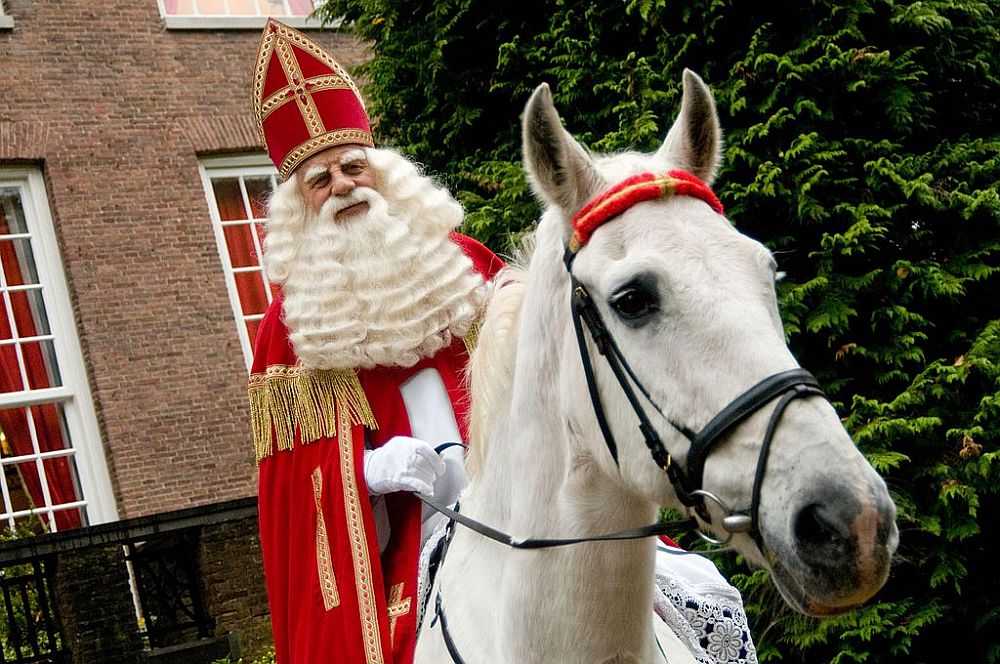
I liked, as well, that since Sinterklaas is no longer a Christian tradition, children received their gifts then: all children, no matter what religion they were. So I could give my kids Sinterklaas gifts without that vague residual guilt that many secular Jews in the US feel if they cave in to the general societal pressure and get a Christmas tree and put up lights.
That left Christmas a truly religious holiday, which some celebrated in church, and many celebrated with a Christmas tree and a big meal at home with family. As non-Christians, we would spend Christmas day quietly at home, watching videos or reading a book.
Small scale, low key: perfect.
Things have changed.
The Dutch Christmas is gradually changing to resemble the American Christmas. While Sinterklaas is still welcomed enthusiastically, businesses are increasingly trying to wring more out of both the Sinterklaas shopping season and Christmas.
In recent years, the Sinterklaas merchandising has begun earlier and earlier. Pepernoten, a small spice cookie that’s traditionally eaten at Sinterklaas time, appeared in the supermarkets in August!
The Christmas lights, normally never appearing until the day after Sinterklaas, went up weeks earlier.
The advertising for gifts of all sorts didn’t let up at all after Sinterklaas; now they reference Santa Claus, American-style (called the kerstman here, or “Christmas man”), and urge gift-giving at Christmas as well.
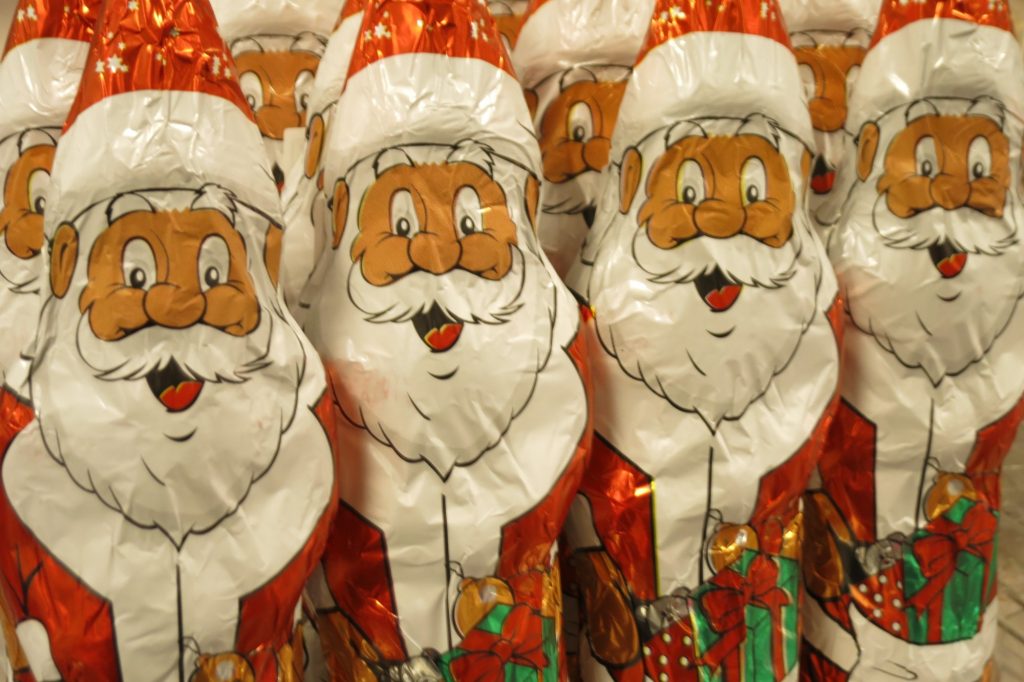
While many Dutch already decorated their houses for Christmas with a candle here and there and a Christmas tree, now whole sections of stores are dedicated to displaying Christmas decorations. Often it’s the usual shiny Christmas ornaments, but lately more stores are selling items with images from the American Christmas story: reindeer pulling a sleigh; Santa carrying gifts, riding in a sleigh; and so on.
It makes no sense here to sell these images. That’s Santa Claus’s story, from America! Why would a Dutch person buy that? Santa Claus has never been part of the Christmas tradition in the Netherlands, nor have reindeer or a sleigh.
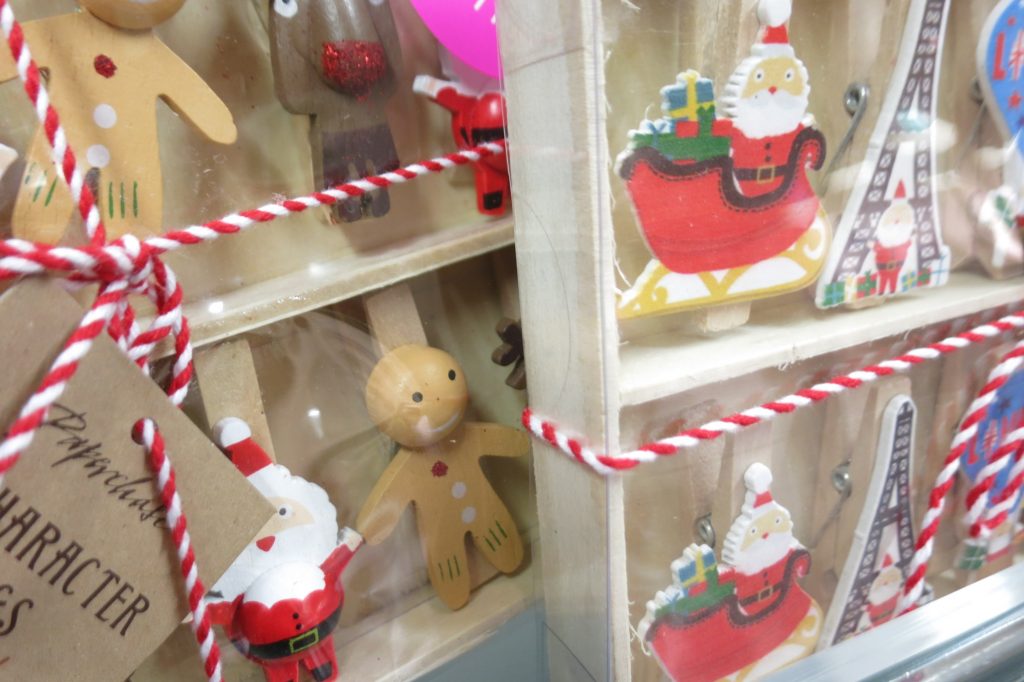
Added in 2020: In the last couple of years, Dutch businesses have even been following the American marketing tactic of holding Black Friday sales. This makes absolutely no sense, since Thanksgiving isn’t celebrated here. How can there be a Black Friday, meaning after-Thanksgiving shopping mania, if there isn’t any Thanksgiving?
I wonder, too, how Dutch people explain all this to small children. When my son, now 17, was little, I told him the story of Sinterklaas – that he lives in Spain and comes to Holland on a steamboat, and that he comes down the chimney to leave presents.
While Sinterklaas and Santa Claus have the same historical roots in Saint Nicholas, they look different and their stories are different. Sinterklaas is tall and thin, carries a crook, rides a white horse, and wears a bishop’s mitre. Santa Claus is fat and jolly, lives in the North Pole, and drives a flying sleigh pulled by reindeer. Two different cultures: two different stories.
When children see all these images of Santa Claus these days, what do Dutch parents tell them? Do they say, as I told my son when he was little, that Santa Claus is a cousin of Sinterklaas and brings gifts to kids in the US? Or are the children getting presents from both Sinterklaas on December 5 and Santa Claus on December 25?
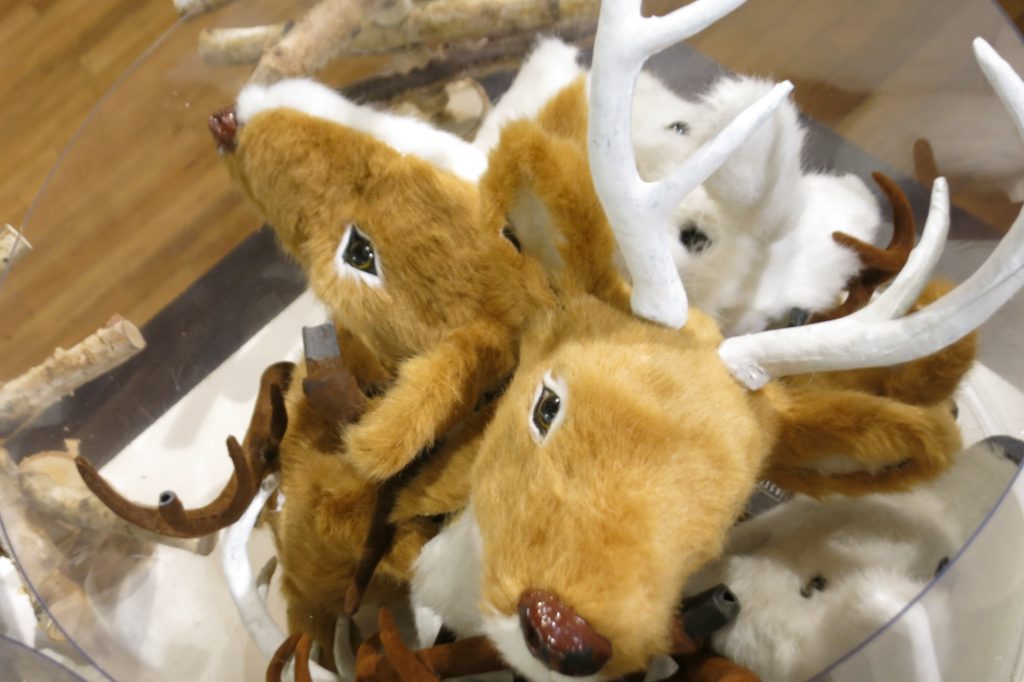
I don’t know, but I fear the worst. I fear that Sinterklaas as a holiday for children will disappear. I fear that it’ll merge into Christmas and become a commercial shopping frenzy like in the US. I fear that those who prefer to celebrate Christmas as primarily a religious holiday will see that meaning get lost in the growing emphasis on gift-giving.
I liked it the way it was.
What is Christmas like where you live? Please add comments below!
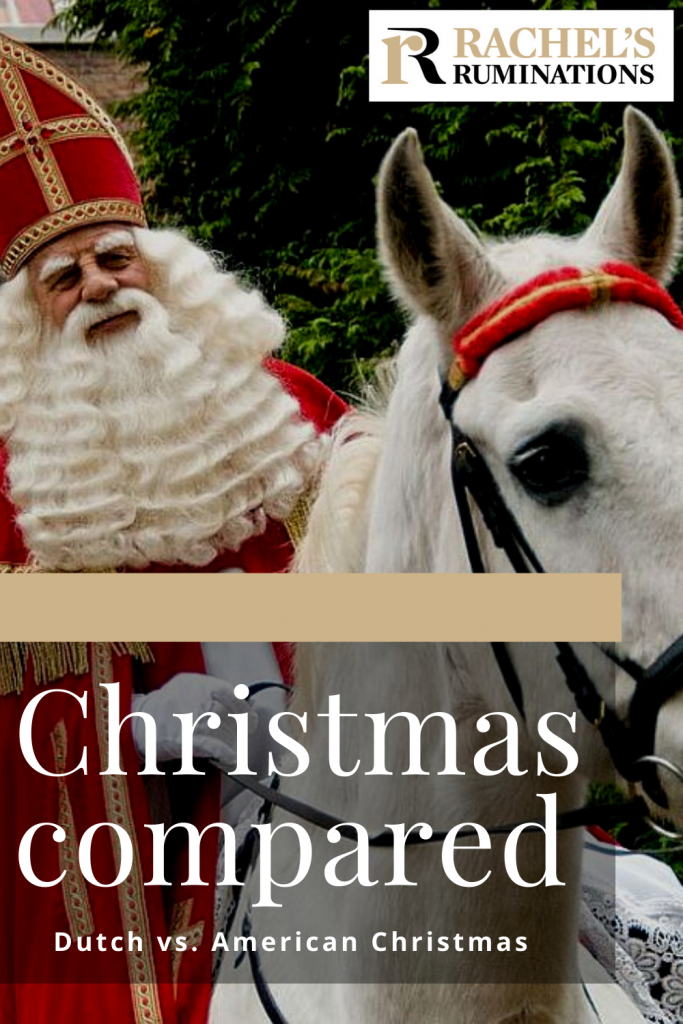


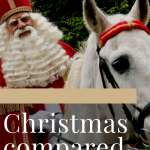

In Australia Christmas is quite commercialised although now with our children grown we don’t feel the pressure of gift buying. It is sad if the Netherlands loses it’s tradition, I’d only just heard of it through your blog and liked its uniqueness.
Yes, the pressure to buy stuff gets less as the kids get older, doesn’t it? But here the stores were a zoo in the days leading up to Christmas, so people are certainly feeling the pressure. Supermarkets too, because everyone seems to need to stock up!
My aim for next year is to worry less about food and just buy a few key luxury food items and leave it at that. 🙂
Sounds like a good plan! Judging by the crowds at supermarkets in December, an awful lot of money gets spent on food!
I’m with you, Rachel. I’ve come to hate how commercialized Christmas has become. It’s becoming increasingly difficult to remember why we celebrate. When I returned to work on the day after Thanksgiving, I was amazed to see Christmas decorations were everywhere! An older woman at work lamented the fact that stores no longer sell Thanksgiving gifts, instead stocking their shelves with Christmas gifts almost right after Halloween.
Can you imagine how Christmas plays in Jamaica? Like most people, we always placed lights on a tree near our house but I’ll never forget years ago, when I spotted a silver Christmas tree with snow (cotton balls) in the living room of a house. I still feel sad when I think about it, about how ridiculous it was, how easily we’re willing to swap our traditions for someone else’s.
Hope you had the kind of Christmas you wanted, Rachel. Wishing you and your family peace and joy in the New Year.
I don’t celebrate Christmas, so the day itself usually involves watching movies and reading. I love reading about Christmas in other places. My Australian friends post about annual Christmas barbeques on the beach! That sounds like my kind of Christmas!
I didn’t realize that Sinterklaas and Santa Clause are so different or that then whole reindeer and sleigh story isn’t an international one. The way you describe how it used to be in the Netherlands seems so appealing, and I can understand your dismay that it’s getting over commercialized. When I lived in Malaysia where only 10% of the population is Christian, I was surprised by how much the stores promoted it. I guess they’re grabbing opportunity where they can. As for how it is in America, I will admit that I hauled gifts for 22 people to my hometown. So many cousins, aunts and uncles to see! I’m trying to think of a way to scale back without everyone criticizing me.
Enjoyed getting your perspectives about Christmas in the Netherlands and sorry to hear it’s going the way of our American Christmas. For the past several years, my husband and I have been kicking off the holiday season in Europe – learning about and experiencing different traditions. It would be a shame to lose the distinct characteristics of Christmas in different countries and regions.
Wow, that sounds like great fun: spending each Christmas in a different country! Since we don’t have any family obligations at Christmas, maybe we should start doing the same!
Interesting how Christmas differs between two tradtioanlly Christian nations … great post!
Thanks, Alana!
Hoi Rachel jij mag dit int engels vertalen voor mij aub,’De gezinnen vieren meestal alleen Sinterklaas òf Kertmis,tenminste wat de grote cadeaus betreft de de kinderen mogen vragen.Vaak met Sinterklaas,als de kinderen wat groter zijn, doen ze al mee aan de suprise avond, die de volwassenen onder elkaar vieren. Je trekt ieder n lootje met n naam van degenen die allemaal meedoen met de suprise avond.Je maakt dan voor diegene een suprise,Dat slaat op iets wat diegene deed/doet,leuk vindt of n grote hekel aan heeft etc.Maar t is meestal iets waarmee je de draak steekt wb die persoon.Verder maken ze ook n rijmpje op die persoon,meestal ook waarbij diegene n beetje op n leuke manier op de hak genomen wordt. Cadeautje(s) wordt vantevoren meestal een prijs afgesproken die er aan besteed mag worden door iedereen,,Vaak ook eigenlijk maar n heel symbolisch bedrag,€5,00 -€15 moet je dan aan denken echt geen grote bedragen.
Kerst is vaker een grotere familie bijeenkomst en elkaar bezoeken(ouders/schoonouders) met 1e en of 2e kerstdag,Of allemaal bij elkaar,Er zijn er die de Kerstman vieren ipv Snterklaas,en dan komen de cadeautjes met de kerst dus.Meestal kiezen ouders die wel vrij zijn met Kerst maar niet met Sinterklaas voor de Kerstmanom het dan te vieren,ook omdat ze langer vrij zijn en danmet de hele familie kersyt samen vieren.Heel veel mensen gaan ook op vakantie met Kerst en Oud en Nieuw!En ontvluchten deze drukke Kerststress.Ook omdat de kinderen dan vaak 2weken vrij zijn,
Ontvluchtte zelf ook n aantal jaren dat hele gedoe.
Moet zeggen dat ik t een verademing vind dat t niet meer zoals heel vroeger zo is datwerkelijk àlles maar dan ook àlles met de kerstdagen gesloten was, ja behalve die Rooms Katholieke Kerk natuurlijk , waar je beide dagen naar toe moest naar die mis..Verder thuis uitgebreid at en n stuk in de bossen ging wandelen omdat je zo ongelooflijk zat te hangen en te eten met de Feestdagen.Al die Kerkelijke toestanden op tv, en de jaarlijkse terugkerende zaken steeds maar weer,t Skischans springen is er overigens nog steeds jaarlijks op 1 januari..Maar oh zo blij dat er nu iig meer keus bestaat dat er veel dingen geopend zijn.Vroeger was dat allemal een schande, dat kòn absoluut niet met de feestdagen. Iedere familie vierde t met hun eigen familie, not done om mensen met Kerst lastig te vallen!! .
I’ll translate this in summary for those who don’t speak Dutch. GH says that most families celebrate only Sinterklaas or only Christmas, at least when it comes to big presents for the children. Often at Sinterklaas, they do a “surprise evening” for the adults. They draw lots with each other’s names and for the person they drew, they make a surprise, which is a thing, that has to do with something the person does or did or what the person likes or hates, etc. They also write a rhyming poem for the person that often makes fun of the person. Usually there’s a price maximum set on gifts, e.g. 5 to 15 euros. Christmas is usually a family occasion: they visit each other on Dec. 25th or 26th. Some use Santa Claus instead of Sinterklaas, in which case the gifts come at Christmas. Families sometimes choose Christmas because it’s when the family is free so they can celebrate together. A lot of people go away on vacation to get away from the Christmas stress and because the kids have two weeks off school then.
She adds that she’s glad that it’s not like it used to be when absolutely everything closed down over Christmas, except the Roman Catholic church, of course, where you had to go to mass on both days. Then home to eat and then go walking in the woods because you ate so much. She’s happy that there is so much choice nowadays and that lots of things are open.